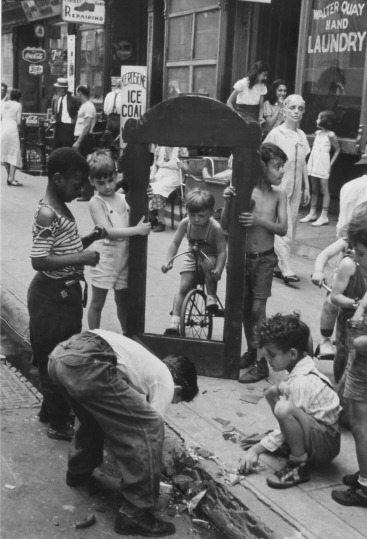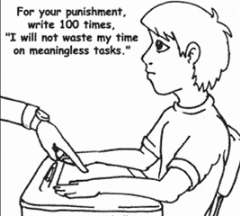
As babies get to the second-half of their first year (around 6 months onward), most will no longer need to feed several times during the night. Their stomachs are generally big enough to hold enough to keep them more or less through the night. The stomach of a newborn can only hold an ounce or two, and few foods are as quickly absorbed and digested as breast milk. So even after a good nursing session, the newborn baby is often hungry again in a couple of hours. They awaken hungry and should, of course, be fed all they want.
But these older babies have also experienced the miracle of positive feedback: when they were younger and cried, mommy miraculously fed them and held them close, spoke to them and comforted them. So even though the need for nutrition during the night is decreased or eliminated, the power of those comforting sensations is as great as ever. So The Human Pacify-ee did improve, but he didn’t extinguish his frequent awakenings through the night, every couple of hours or so.
When the Pacifier recently returned to the office with him, I assumed it was for the same problem. I asked her if she had followed some of my suggestions. She said she did some but not others. She thought his frequent awakenings had improved a lot, but she just couldn’t take the last couple of steps. ’It’s not a problem for me,’ she kept on saying.. She had to choose a spot she felt comfortable with, of course. But I would not let her say it doesn’t work if she gives up on it. And though she might be able to tolerate this at this age, how will it be when the child is 3 and she’s back in my office complaining that the child is coming into her bedroom and bed every night and preventing her from getting any sleep.
I told her that it was OK with me, of course, for her to choose what she is and is not comfortable with doing.
 Baby walkers were a big hit several years ago. Babies adore them, so parents are enthusiastic too. Gradually, however, Emergency Rooms across the country started to see the injuries they caused, some of them really serious. A walker gives a baby who can’t walk the ability to move themselves wherever they want to go.
Baby walkers were a big hit several years ago. Babies adore them, so parents are enthusiastic too. Gradually, however, Emergency Rooms across the country started to see the injuries they caused, some of them really serious. A walker gives a baby who can’t walk the ability to move themselves wherever they want to go.But they don’t see obstructions or problems ahead of their path. The really bad injuries tended to be of two types. 1. Stairs. Once the walker rolled over that top step, it would tumble. Once the walker tips over, the baby’s body and legs are protected, and the full impact lands on the most exposed part of the baby: the head. 2. Pulldown. As every puppy knows, there’s a lot of interesting and delicious things on tabletops that they just can't see. The baby who can’t walk now has the walker to get them over to the side of the table or the side of the stove or ironing board. The walker keeps them upright in a position they are not developmentally capable of doing on their own. With both of these new capabilities, they can finally indulge their curiosity to see what happens when they pull on the handle of that brightly-colored pot on the stove they are standing right next to.
Babies are genuine explorers. They want to see the edge of the world, perhaps just around the corner. So, since The Human Pacifier was told in no uncertain terms by me that there would be no walker in their house, she finds herself metamorphosed, like a reluctant chrysalis, into The Human Rickshaw. When I pointed this out to her, she pointed out that this was a particularly luxurious rickshaw: it served only one customer, and had The Human Pacifier on-call at all times to meet the whims of its master.
The Human Rickshaw explained to me that she knew she was summoned by a brief grunting cry and a quick movement of two arms thrust vertically into the air, as if clearing up any ambiguity about a contested goal. If not picked up within the appropriate pickup-time window, the rickshaw passenger lodges a formal complaint to management. When I pointed out this pattern to The Rickshaw, of which she had been wholly unaware, she said she wasn’t worried about it because, ‘It’s not a problem for me.’ Though happy that it was not a problem for her, I probed further into the everyday activities at home. It turns out that this PhD scientist had swapped roles with the subject of the experiment.
In responding to my frequent suggestion that parents be the grown-up, there are several definitions of adulthood. This baby wasn’t paying the rent, buying the food, changing his own diapers. But he was firmly calling the shots with mommy in most important ways--the ways that affected mommy’s life in a problematic way.
This is not naughty behavior! There is no discipline, no punishment, no consequences that should ever be used in a baby this age. Though his behavior is inconvenient, perhaps a pain in the neck, where did he learn it? How did he choose it?
For all children who are no longer newborns, there is only one Holy Grail, only one irresistible drug. That is a parent’s attention. They will experiment with every kind of behavior that comes to mind. Sometimes this includes biting, hitting, pinching, screaming in ways that, if continued, could cripple our domestic glass-making industry. This child was a prodigy at this developmentally-normal task. But he needed an adult as his mother. Someone who could turn away instead of dutifully lowering the arms of the rickshaw yet again, and silently hoping that the baby’s destination would leave her somewhere near the office of the backache clinic.















